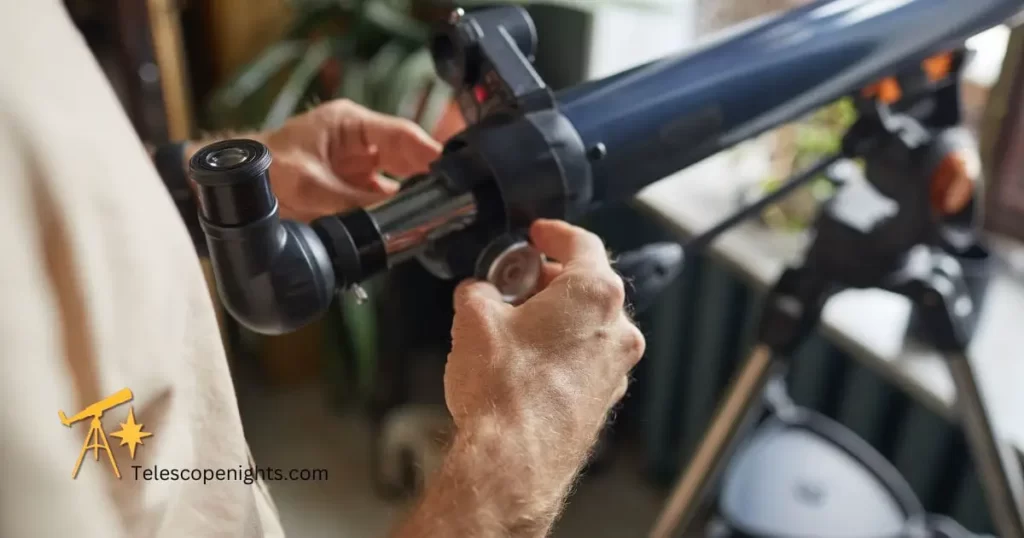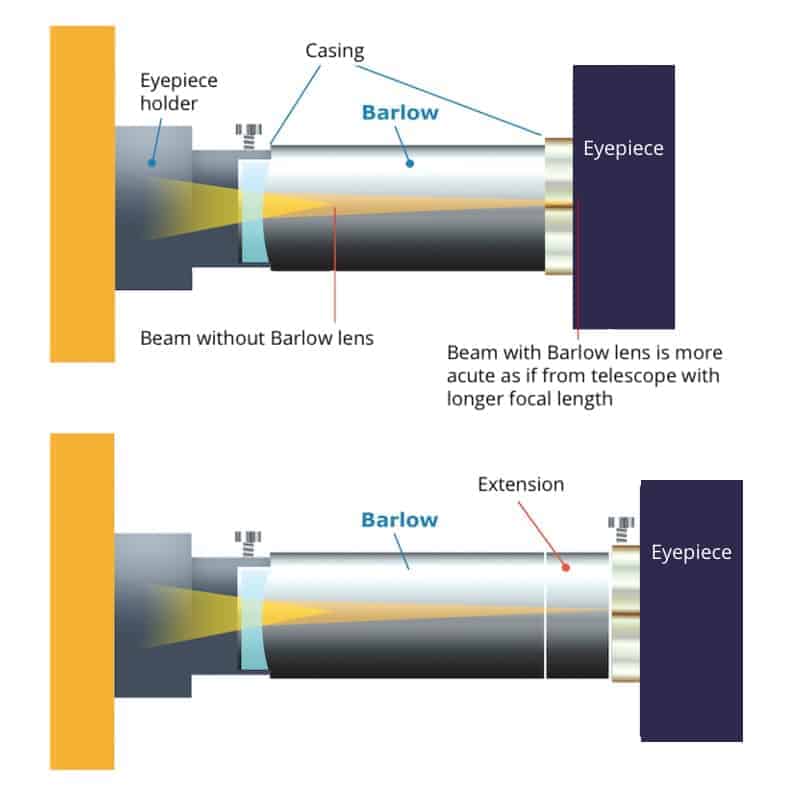Getting the most out of your telescope can depend on how well you know the accessories as well as what to look for when buying them. Getting the good oil on what to know about buying and using a Barlow lens in a telescope certainly helps.

Key takeaways
Barlow lenses are essentially magnifying lenses inserted between the telescope and eyepiece. They range from 2x to 5x, which combined with different eyepieces provide a range of higher magnifications. However, there are limits to these combinations…
What is a Barlow lens in a telescope used for?
A Barlow lens is an accessory that increases magnification and virtually extends your eyepiece collection.
The Barlow lens explained…
The Barlow Lens was invented in the 1800s by the English mathematician and physicist Peter Barlow (13 October 1776 – 1 March 1862). The lens structure of a Barlow lens is relatively simple. It consists of a negative lens element that is placed at a specific distance from the telescope’s objective lens or primary mirror.
In most Barlow lenses, the negative lens element is housed in a metal or plastic barrel that is threaded to fit into the telescope’s focuser. Some Barlow lenses also come with an additional lens element that is placed on the other side of the negative lens element, which can further increase the magnification.
How does a Barlow lens work?
The negative lens element design diverges the light that passes through it to effectively increase the focal length of the telescope. This increased focal length results in a higher magnification of the image you are viewing.
The beauty of using a Barlows is that you effectively double or triple the magnification without having to switch between eyepieces.
For example, if your telescope comes with two eyepieces and a Barlow lens, you have the flexibility of using higher magnification with just the two you have. Effectively you have the benefit of four eyepieces.
What Difference Does A Barlow Lens Make?
The difference that a Barlow lens makes is that it is a cost-effective way of improving the magnification power of your telescope – for seeing more details of the moon or planets, for example – without having to purchase a more expensive telescope or extra eyepieces for higher magnification.
It’s important to note that using a Barlow lens can also affect the brightness and clarity of the image you are viewing, so it’s important to find the right balance between magnification and image quality.
For more on this: See my guide to choosing telescope eyepieces
What does a Barlow lens do?
A Barlow lens increases the power of your telescope by increasing the telescope focal length as it creates a more acute diverging cone of light.
It can help get you a better view of the details of planets.
How to Install A Barlow Lens in telescope
Installing a Barlow lens on a telescope is a simple process. Here’s a step-by-step on how to use a Barlow lens on a telescope with a diagram to follow that will further help.
- Ensure your telescope eyepiece is removed.
- Take the Barlow lens and remove the cap from the end that will be inserted into the telescope.
- Carefully insert the Barlow lens into the telescope’s focuser, ensuring that it is securely in place.
- Once the Barlow lens is in place, insert the eyepiece into the Barlow lens.
- Adjust the focus of the telescope and enjoy the increased magnification power that the Barlow lens provides.
Note: Not all Barlow lenses are compatible with all telescopes, so be sure to check the specifications of your telescope and Barlow lens when buying the accessories.

How to use a Barlow lens on telescope when using a star diagonal
Where does a Barlow lens go on a telescope if I’m using a star diagonal? Quick answer: You can place the star diagonal either ahead or behind the Barlow lens.
Where the Barlow lens is placed behind the star diagonal (between the star diagonal and the eyepiece), i.e., placing the star diagonal ahead of the Barlow lens, you’ll achieve the expected focal length or amplified magnification using the Barlow lens.
However, in placing the star diagonal behind the Barlow lens (between the Barlow lens and the eyepiece) you will get the best effect when using a refractor telescope vs a reflector. In all, try it out to see what works for you.
Tip: Keep fingers away from the lens part when fitting. Fingers leave oil and grease on the lens and this will require cleaning. I explain how best to remove these deposits in my article covering the dos and don’ts of cleaning telescope eyepieces.
What to know about a Barlow Lens 2x or 3x etc
When buying Barlow lenses make sure you have the right barrel size, magnification, and the type of Barlow that suits your telescope.
Correct barrel size first up
No matter what magnification, it’s critical to choose a Barlow lens that has the correct barrel size for the telescope focuser, that is, 1.25 or 2 inches, or if you have the more expensive eyepieces, check the size, e.g. it could be 0.965 inches.
Barlow lens magnification, 2x, 3x, 4x, 5x
This should answer your question about what is and how to use a 2x Barlow lens and other magnifications.
The most common Barlow lens included when you purchase a telescope for beginners is the 2x.
What does A 2x Barlow lens do? A 2x Barlow lens doubles the magnification of your eyepieces. It does this by increasing the focal length of the telescope.
Example: if you have three eyepieces, say with focal lengths of 10, 16, and 25 mm, by adding a 2x Barlow lens you get the experience of six, i.e. 5, 8, 12 mm as well as 10, 16, and 25 mm.
Similarly, a 3x Barlow triples the magnification, a 4x quadruples it, and so on.
Before choosing these, you need to take into account the maximum magnification limit of your telescope and the eyepieces you already own. Whether you opt for a 2x, a 3x, 4x, or 5x Barlow lens will depend on these. If they mean you go beyond the practical limits of your telescope kit then they would be useless to buy.
I wrote more about the restriction with power limits in my article on choosing the right eyepiece kit that will be helpful for this. But to demonstrate how you need to know the size of the eyepiece you already have, here’s an example…
In terms of eyepieces you already have: If you own 10 mm and 5 mm eyepieces, getting a 2x Barlow won’t benefit you as a 10 mm with a 2x Barlow will give you a 5 mm effect — which you already have. This is purely for explanation reasons as generally, you won’t have a 10 and a 5 offered together.
As well as above you can also get adjustable Barlows where power is increased by adding an extension tube between the Barlow and the eyepiece.
Quality images
For the best quality images, look for a Barlow with fully multi-coated lenses to minimize stray and reflective light and maximize the light coming through to your eye.
Lens elements
Barlow lenses may have optic systems with 2- to 5-element lenses. A Barlow lens with three or more lens elements in its optics system will typically give you better-quality images.
Achromatic lenses are generally 2-element lenses fused together but can involve three elements, as noted by Edmund Optics. No matter the number, achromatic lenses correct for two wavelengths of visible light (red and blue) to improve aberration effects. Apochromatic lenses are an advancement of the achromatic and involve at least three lenses fused together in the optic system.
Advantages of using a Barlow Lens
Four common reasons for using a Barlow lens…
- Increased magnifications. This gets around the aberrations of having to use short focal length eyepieces that have curved optical surfaces.
- Increased focal ratio. This improves the focus. Great in cases where eyepieces with short focal-ratio objectives do not work well.
- A more acute light cone. A higher effective focal ratio of the eyepiece objective means less demand for the eyepiece quality.
- Cone peripheral rays are more paraxial and less subject to aberration, and
- There’s a smaller area of the field lens.
- Better eye relief for eyeglass wearers, since the eye relief of eyepieces typically relates to eyepiece focal length (in some cases this can be a disadvantage – see notes above).
The one main disadvantage of using a Barlow lens can be a slight loss (around 3%) of light.
Video: How to use a Barlow lens
For Barlow lens advice in visual format…
FAQs
What Is A Shorty Barlow lens?
A shorty Barlow is a compact lens; hence its name. It has a short barrel of about 1.6 inches in length. End to end, its length is 3 inches, which is about half that of the standard Barlow lens.
Can I Use 2 Barlow Lens Together?
You can pair them up but think about what you’re wanting to look at before venturing deep.
In summation
Eyepieces may come and go, but it is worth getting a good quality Barlow lens to last the test of time and extend your collection of eyepieces to get a better experience without costing a lot of money.
Info sources
Scientific American: The Amateur Astronomer | The Astronomical Unit: Barlow Lens | Edmund Optic: Anatomy of Achromatic Lens
- Journal of the British Astronomical Association. (1967). United Kingdom: British Astronomical Association. Vol. 78. p 64-68

